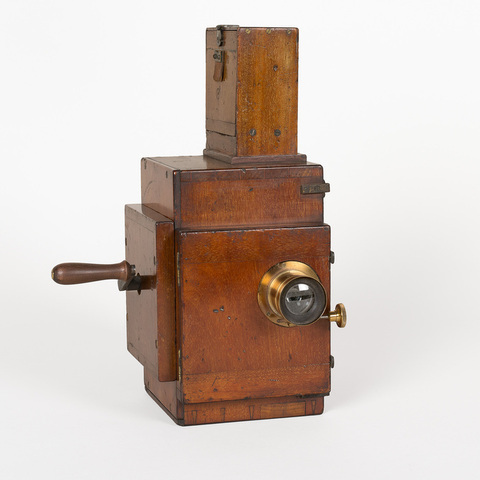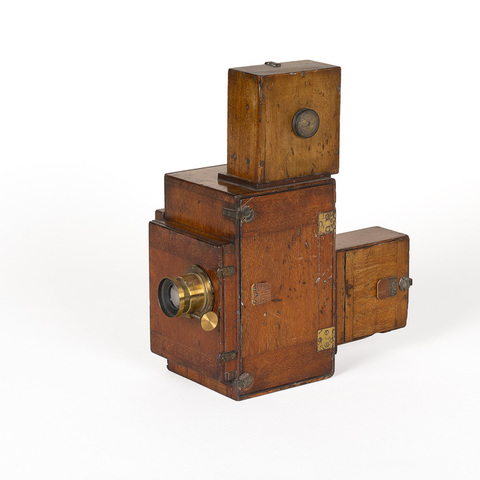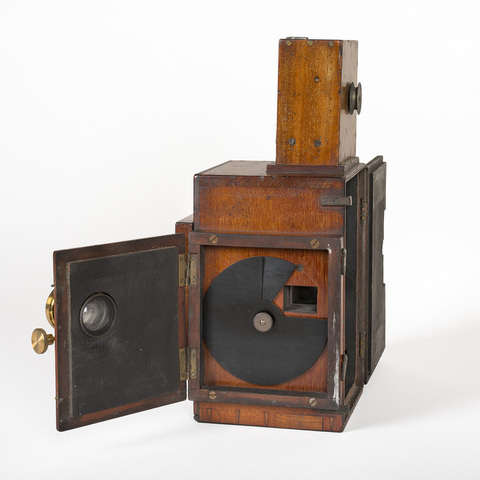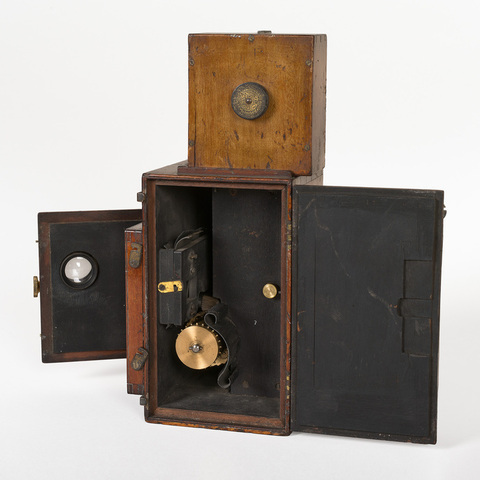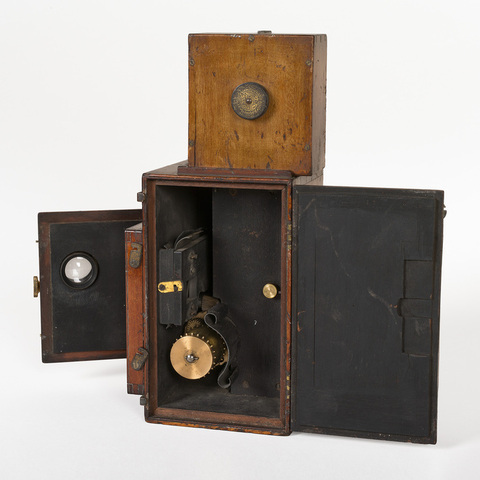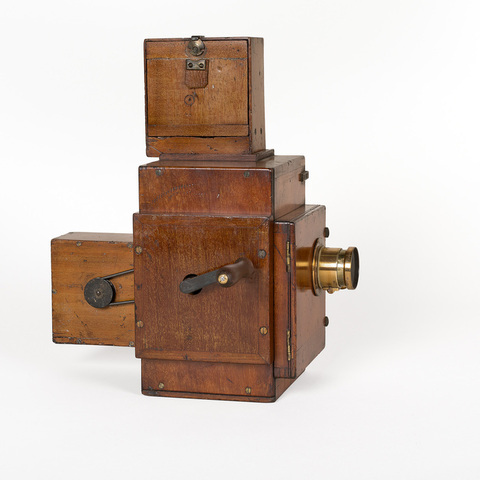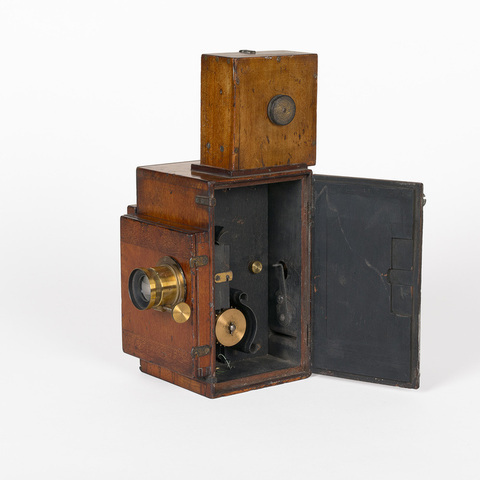Caméra réversible film 35 mm
Fiche détaillée
Type de l'appareil
entraînement du film 35 mm par un débiteur denté monté sur un disque excentrique ; double obturateur superposé réglable pour prise de vues ou projection ; magasin débiteur pour 20 m de pellicule ; magasin récepteur ; objectif à crémaillère ; manivelle
Auteurs
Friese-Greene William
Londres, 39 King's Road, Chelsea
Prestwich John Alfred
Londres, 744 High Road, Tottenham
Fabricants
John Alfred Prestwich
Londres, 744 High Road, Tottenham
Utilisateurs
Friese-Greene William
Londres, 39 King's Road, Chelsea
Prestwich John Alfred
Londres, 744 High Road, Tottenham
Distributeurs
John Alfred Prestwich
Londres, 744 High Road, Tottenham
Sujet du modèle
Informations non disponibles
Objectif
Informations non disponibles
Taille de l'objet
Ouvert :
Informations non disponibles
Fermé :
Longueur : 28 cm
Largeur : 22 cm
Hauteur : 31.2 cm
Diamètre :
Informations non disponibles
Taille de la boîte de transport
Informations non disponibles
Remarques
Marque sur le mécanisme intérieur : "J. A. Prestwich".
"This invention relates to improved means for taking and for reproducing kinetoscopic pictures, that is to say, for taking and for projecting upon a screen in rapid succession a number of transparent photographs of animated scenes or of a moving object in such a manner as to produce upon the screen an exact picture of the animated scene or moving object which was photographed in the first instance. In carrying out our invention we use a strip of transparent sensitive film on which we take a series of photographic negatives in rapid succession. For the purpose of reproduction the series of photographic negatives on the film is printed, to form transparencies or positives, on to another strip on film. The apparatus used in photographing can also be adapted for printing the positives by running the negative and the film on which the positive is to be made, through the apparatus together in contact with each other. The photographic apparatus can also be adapted for projecting by inserting a condenser at the back of the apparatus, but we prefer to use a separate apparatus which may contain two or more lenses and apertures for projecting the pictures on to the screen, the lenses being arranged to converge, so that the pictures projected by the two or more lenses shall fall in the same place and position on the screen. [...] The drum is fitted with a circular peripheral row of pins which engage in perforations provided in the two longitudinal edges of the film which passes over the drum. [...] We declare that what we claim is : 1. In apparatus for taking or for exhibiting photographs in rapid succession, a film drawing device comprising a drum mounted on a crank pin driven by an epicyclic train of wheels substantially as hereinbefore described. 2. In apparatus for taking or for exhibiting photographs in rapid succession and in which a lenght of films is employed, formed with a film-drawing device comprising a drum with pins to engage with the film perforations the said drum being mounted on a crank pin and driven from a continuously revolving shaft by means of an epicyclic train of wheels [...]. 3. In apparatus for taking and for exhibiting photographs in rapid succession and in which a lenght of film is employed without driving perforations, a film drawing device comprising a drum mounted on a crank pin and driven from a continuously revolving shaft by means of an epicyclic train of wheels in combination with rollers carried by a second epicyclic train of wheels for pressing the film in contact with the drum. [...] Dated this 28th day of April 1897" (William Friese-Greene, John Alfred Prestwich, BP n° 17 224, date of application 4 août 1896, complete specification left, 30th April 1897, accepted 24th July 1897, "Means for Taking and Reproducing Kinetoscopic Pictures").
"The Prestwich Manufacturing Co., of 744 High Road, Tottenham, was destined to become one of the most important manufacturers of cinematographic equipment in Gt. Britain. The founder of the firm appears to have been W. H. Prestwich, an able, if undistinguished portrait photographer, with studios at High Road and 155 City Road. Also associated with the firm was John Alfred Prestwich (1874-1952), whom we have already had occasion to mention in connection with a rather bizarre cinematograph patented by himself and William Friese-Greene in August 1896. J. A. Prestwich profession is stated in the patent specification as that of engineer. He was clearly the brains behind the whole Prestwich enterprise and his technical brilliance is further demonstrated by his subsequent development of the JAP motorcycle engine. The relation between W. H. and J. A. Prestwich has not been determined, but it seems likely that they were father and son. [...] The first apparatus openly associated with Prestwich was the Moto-Photograph, that very same apparatus which Hughes put on the market as the Moto-Bijou Living Picture Camera. [...] W. C. Hughes probably received supplies of the new apparatus almost immediately, for he advertises it in The Era for 1 May. A few days later, the apparatus was demonstrated by its designer, "Mr. Prestwich", at a meeting of the Hackney Photographic Society, held on 11 May [...]. In the June issue of The Photogram, the apparatus is advertised by the Moto-Photo Supply Co, as the "Prestwich Camera", and a paragraph in the same issue gives a description of the apparatus : "Another new apparatus which seems to combine in a marked degree many useful characteristics, has been named the Prestwich. It is light, compact, and very smooth in its working. On the screen it ought to give a very steady picture, and its price is low. The whole of the working parts are contained in a mahogany case of small size, which makes it an easily portable machine and one in which the mechanism is well protected... The main sprocket wheel is excentrically pivoted so that while it is making a part turn around its main axis it makes a complete turn round the excentric axis, thus rapidly drawing off the lenght of film equal to one picture. The take-up reel is driven by a friction-gear so that it gathers the slack of the film which has passed the sprocket wheel, but cannot subject it to any strain". [...] The price of the Prestwich camera was £ 18, but a more expensive model, costing £ 38, was also made, which was fitted with daylight loading exterior film boxes taking 500 ft of film. Examples of both these cameras are to be found in the Jones-Frank Collection. [...]" (John Barnes, The Rise of the Cinema in Gt. Britain, volume 2, Jubilee Year 1897, London, Bishopsgate Press, 1983, p. 53-63).
A noter que notre modèle comporte des magasins extérieurs, mais pour 20 m environ de pellicule. Il s'agit donc d'un modèle intermédiaire entre la première version au prix de £ 18 et la deuxième à £ 38, équipée de magasins de 150 m.
Bibliographie
John Barnes, The Rise of the Cinema in Gt. Britain, volume 2, Jubilee Year 1897, London, Bishopsgate Press, 1983, p. 53-63.
